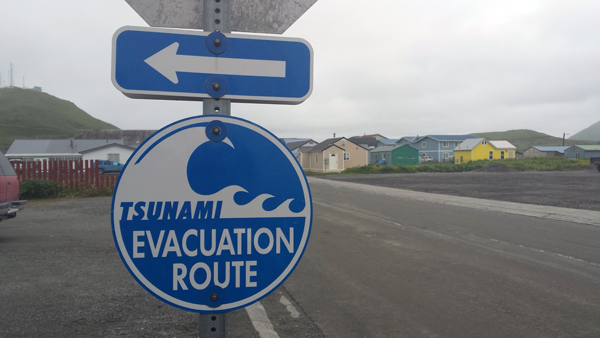At a magnitude 7.9, last week’s deep-sea earthquake was the most powerful to hit the Western Aleutians in 50 years. The quake didn’t cause any structural damage — but it was a reminder that life in the islands can change in an instant.
The first tsunami warning issued after last Monday’s earthquake didn’t include Unalaska. In fact, the quake’s epicenter was far away from the town – deep underwater, 600 miles across the chain.
But that didn’t stop residents from taking notice.
“A lot of folks might have just caught a little — tidbits of it, such as the word Aleutians — earthquake — evacuation, when the warning was further down the chain,” says Unalaksa public safety director Jamie Sunderland.
He says they started getting calls about the quake and the tsunami risk almost immediately. They only had one dispatcher on duty, and had to scramble to bring in extra staff.
When a tsunami advisory was issued for Unalaska a short time later, he says it was tough to get the message out – that residents didn’t actually need to evacuate. Some were already heading for high ground.
Of course, Unalaska had practiced for a day like this during the statewide tsunami drill just a few months before. But Sunderland says their experience this time, showed some things are out of their control.
“Think back to grade school where they had you do a little exercise where you whisper a certain phrase into someone’s ear, and by the time it comes around the room, the message is completely changed,” he says. “The same thing happens as we pass messages through our various systems, as we try and abbreviate things.”
In Adak – just a couple hundred miles from the quake’s epicenter — the message about getting to high ground was a lot clearer:
“Given the duration and intensity of the earthquake, most people didn’t need much warning to go up there,” says city manager Layton Lockett.
He says they sounded their tsunami siren right after they felt the quake. And together, about 100 Adak residents stopped what they were doing and headed for the town shelter, an old church on a hill.
“It actually worked very well,” Lockett says. “Better than any drill we could have planned for.”
Despite the strength of the quake, Adak didn’t see any damages. In fact, the disaster’s only victims may not have been people or property at all.
Seabirds on nearby Buldir Island build their nests in rocky cliffs. When the earthquake hit, parts of those cliffs collapsed or slid away – crushing some eggs and killing chicks in the process.
Alaska Maritime National Wildlife Refuge director Steve Delehanty was visiting Adak during the quake. He says there’s no way to tell how many of Buldir’s kittiwakes, murres and auklets were lost. But he also says it’s part of the natural cycle – the birds are well adapted to a changeable environment.
“There’s a short-term impact to birds, but it’s the very forces of nature that those birds depend on in the long run to provide their habitat,” Delehanty says.
The same is true of the people that live on the chain. Life in the Aleutians means expecting the unexpected – from volcanic eruptions to earthquakes and tsunamis – even when all that washes ashore is a wave less than a foot tall.
Annie Ropeik is a reporter for KUCB in Unalaska.





